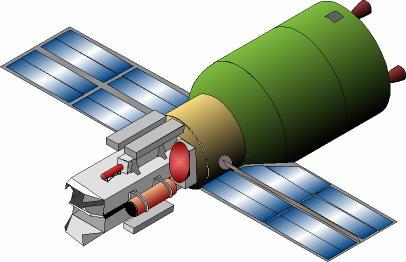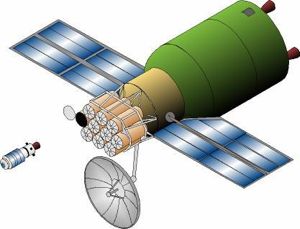
Home - Search - Browse - Alphabetic Index: 0- 1- 2- 3- 4- 5- 6- 7- 8- 9
A- B- C- D- E- F- G- H- I- J- K- L- M- N- O- P- Q- R- S- T- U- V- W- X- Y- Z
USB

DOS Laser
Isometric drawing of derivative of Almaz / Mir space station as laser space battle station.
Status: Study 1978. Gross mass: 20,000 kg (44,000 lb).
The USB was equipped with common service systems and rocket engines. In comparison to the DOS the USB had much larger propellant tanks to allow substantial orbital maneuvering. The USB would be equipped with either a laser payload or a weapons bay consisting of ten miniature rocket homing vehicles.
The Proton launch vehicle would be used to launch a 20 metric ton version of the USB for experimental flight tests. Operational 30 metric ton vehicles would be delivered to orbit by the Buran space shuttle. Buran would also bring crews for on-orbit servicing of the USB. For this purpose the USB had a life support capability of two crew for seven days.
The mass of the military payload depended on the amount of propellant loaded. The laser payload was heavy with a resulting lower fuel fraction and was limited to use against low earth orbit targets. The UBM with the rocket homing vehicles had more propellant and could be used for attack of geostationary orbit targets.
Family: anti-satellite. Country: Russia. Launch Vehicles: Proton, Energia. Agency: Korolev bureau, MO.
 | DOS Pebbles Isometric drawing of derivative of Almaz / Mir space station as 'Brilliant Pebbles' space interceptor launcher. |
Back to top of page
Home - Search - Browse - Alphabetic Index: 0- 1- 2- 3- 4- 5- 6- 7- 8- 9
A- B- C- D- E- F- G- H- I- J- K- L- M- N- O- P- Q- R- S- T- U- V- W- X- Y- Z
© 1997-2019 Mark Wade - Contact
© / Conditions for Use